Baker's cyst
A full range of orthopedic services, from diagnosis to full recovery
Baker's cyst (Becker's, popliteal cyst) is the result of an inflammatory process of the mucous interstitial bags between the tendons of the middle head of the calf and semipereminous muscles. Such interstitial mucosal bags are a variant of development and exist in half of healthy people. The disease develops only when these bags develop an inflammatory process, accompanied by an increase in the size of the bags, pain and impaired movement in the knee joints.
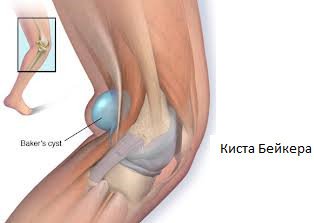
CAUSES OF BAKER'S CYST (Becker's, popliteal cyst)
The cause of the development of inflammation is inflammatory diseases of the knee joint itself: diseases of the meniscus, deforming osteoarthritis.
The mucosal tendon sacs are connected to the knee joint cavity through a narrow slit-like opening. With inflammation of the inner lining of the knee joint, inflammatory fluid from the joint cavity enters the bag, accumulates there and causes the formation of a cyst. The cyst has a special valve (the so-called plug), which prevents the reverse outflow of fluid from the cyst into the joint cavity.
WHAT IS A BAKER'S CYST OF THE KNEE JOINT?
The cyst is a dense elastic formation of a rounded shape in the upper corner of the popliteal fossa, slightly displaced inside. When probing, pain is felt.
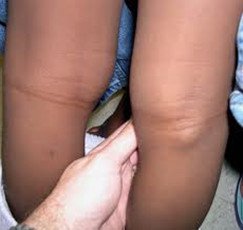
To clarify the diagnosis, an ultrasound examination of the knee joint or magnetic resonance imaging (MRI) is performed.
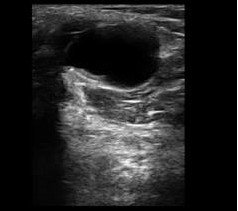
Ultrasound examination revealed a Baker's cyst.
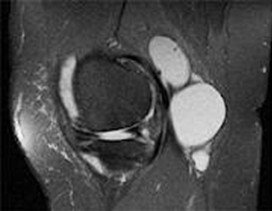
View of Baker's multicameral cyst on MRI.
COMPLICATIONS OF BAKER'S CYST
The most common complication of a Becker cyst is its rupture, with fluid from the cyst penetrating into the abdomen of the calf muscle. This complication develops in every 10 patients with Baker's cyst. Baker's cyst rupture is manifested by thickening of the calf, redness, local fever, pain and swelling on the back of the lower leg may appear.
Due to its anatomical location, Baker's cyst can serve as a factor in obstructing the outflow of blood through the veins of the lower leg, inflammation of the walls of the veins (thrombophlebitis) with further blockage of the lumen of the vein by a blood clot (thrombosis).
Naturally, when bending the knee joint, for example, when squatting, the cyst and the surrounding soft tissues are squeezed. There is pain, the person can not sit down completely.
In some cases, it is possible to deposit calcium salts in the cyst itself, as a result of which the cyst thickens, the patient begins to "feel" it more strongly, the cyst squeezes the surrounding tissues more strongly, causing serious threats to the patient's health.
TREATMENT OF BAKER'S KNEE CYST
Conservative treatment
Conservative treatment of a cyst is to treat the disease that led to its formation. Usually these are inflammatory diseases of the joints, which provide the necessary "substrate" to fill the cyst with inflammatory fluid.
Until recently, the treatment of Baker's cyst consisted of puncturing the cyst. The cyst was pierced with a puncture needle, the fluid was removed, and hormonal drugs - glucocorticosteroids-were injected into the cyst cavity.
However, to date, this method of treatment is considered ineffective, since after some time after the puncture, fluid is again collected in the cyst, which enters it from the joint cavity, and it can not go back out because of the valve, which passes fluid only in one direction - from the joint cavity to the cyst. Therefore, the only way out in this situation is to remove the valve, and this is only possible by removing the valve with arthroscopy.
Surgical treatment
Previously, the standard of surgical treatment was the removal of a cyst. In the popliteal region, a long incision of 10 to 15 centimeters was made above the cyst. Carefully separating the soft tissues of the popliteal region (to avoid damage to the popliteal vessels and nerves), a cyst was isolated. The junction of the cyst with the knee joint cavity was stitched, bandaged, and the cyst was cut off.
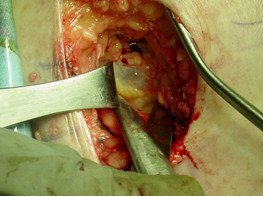
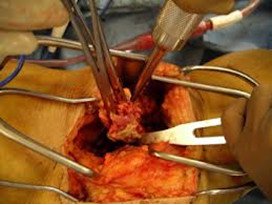
Such operations are quite traumatic for patients, require a long hospital stay (7 or more days), are often accompanied by the formation of painful scars in the popliteal region, more serious rehabilitation, and longer recovery periods after surgery.
Removal of cysts by arthroscopy
Arthroscopy is the most modern and" low-traumatic " method of surgical treatment of Baker's cyst.

CAUSES OF BAKER'S CYST (Becker's, popliteal cyst)
The cause of the development of inflammation is inflammatory diseases of the knee joint itself: diseases of the meniscus, deforming osteoarthritis.
The mucosal tendon sacs are connected to the knee joint cavity through a narrow slit-like opening. With inflammation of the inner lining of the knee joint, inflammatory fluid from the joint cavity enters the bag, accumulates there and causes the formation of a cyst. The cyst has a special valve (the so-called plug), which prevents the reverse outflow of fluid from the cyst into the joint cavity.
WHAT IS A BAKER'S CYST OF THE KNEE JOINT?
The cyst is a dense elastic formation of a rounded shape in the upper corner of the popliteal fossa, slightly displaced inside. When probing, pain is felt.

To clarify the diagnosis, an ultrasound examination of the knee joint or magnetic resonance imaging (MRI) is performed.

Ultrasound examination revealed a Baker's cyst.

View of Baker's multicameral cyst on MRI.
COMPLICATIONS OF BAKER'S CYST
The most common complication of a Becker cyst is its rupture, with fluid from the cyst penetrating into the abdomen of the calf muscle. This complication develops in every 10 patients with Baker's cyst. Baker's cyst rupture is manifested by thickening of the calf, redness, local fever, pain and swelling on the back of the lower leg may appear.
Due to its anatomical location, Baker's cyst can serve as a factor in obstructing the outflow of blood through the veins of the lower leg, inflammation of the walls of the veins (thrombophlebitis) with further blockage of the lumen of the vein by a blood clot (thrombosis).
Naturally, when bending the knee joint, for example, when squatting, the cyst and the surrounding soft tissues are squeezed. There is pain, the person can not sit down completely.
In some cases, it is possible to deposit calcium salts in the cyst itself, as a result of which the cyst thickens, the patient begins to "feel" it more strongly, the cyst squeezes the surrounding tissues more strongly, causing serious threats to the patient's health.
TREATMENT OF BAKER'S KNEE CYST
Conservative treatment
Conservative treatment of a cyst is to treat the disease that led to its formation. Usually these are inflammatory diseases of the joints, which provide the necessary "substrate" to fill the cyst with inflammatory fluid.
Until recently, the treatment of Baker's cyst consisted of puncturing the cyst. The cyst was pierced with a puncture needle, the fluid was removed, and hormonal drugs - glucocorticosteroids-were injected into the cyst cavity.
However, to date, this method of treatment is considered ineffective, since after some time after the puncture, fluid is again collected in the cyst, which enters it from the joint cavity, and it can not go back out because of the valve, which passes fluid only in one direction - from the joint cavity to the cyst. Therefore, the only way out in this situation is to remove the valve, and this is only possible by removing the valve with arthroscopy.
Surgical treatment
Previously, the standard of surgical treatment was the removal of a cyst. In the popliteal region, a long incision of 10 to 15 centimeters was made above the cyst. Carefully separating the soft tissues of the popliteal region (to avoid damage to the popliteal vessels and nerves), a cyst was isolated. The junction of the cyst with the knee joint cavity was stitched, bandaged, and the cyst was cut off.


Such operations are quite traumatic for patients, require a long hospital stay (7 or more days), are often accompanied by the formation of painful scars in the popliteal region, more serious rehabilitation, and longer recovery periods after surgery.
Removal of cysts by arthroscopy
Arthroscopy is the most modern and" low-traumatic " method of surgical treatment of Baker's cyst.
Product rating is: 0 from 5
Please rate the product:
Advantages of treatment in Orthopedics by Ruslan Sergienko
-
10 years on medical services in Ukraine
-
> 25 years of experience with leading specialists
-
Anna Vovchenko and Ruslan Sergienko are recognized opinion leaders among the orthopedic traumatologists
-
> 150,000 consultations were held
-
> 7,500 surgeries were performed
-
All types of pain management
-
The operating unit is equipped according to international standards
-
Availability of all medicines and supplies
-
Single rooms, equipped with the characteristics of orthopedic patients
-
Three meals a day
-
Postoperative rehabilitation by certified specialists
-
Pricing Transparency
